Exploring the Gold Souk: Culture and Commerce in Dubai
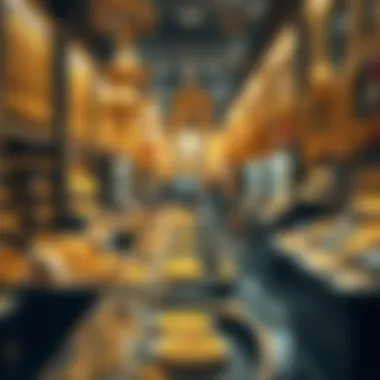

Intro
Dubai’s Gold Souk isn’t just a market; it’s a vivid tapestry woven from strands of history, commerce, and cultural exchange. Nestled in the heart of the city, this souk is a treasure chest of exquisite gold jewelry, showcasing craftsmanship that attracts visitors from all around the globe. The aroma of spices and the sounds of haggling fill the air, creating an immersive atmosphere that envelops anyone who strolls through its narrow lanes.
The journey into the Gold Souk is not merely about shopping but also an exploration of its pivotal role in the local economy and the cultural fabric of Dubai. With gleaming displays reflecting sunlight, vendors beckon passersby, eager to share stories behind their creations. Each piece of jewelry not only tells a tale of beauty but also resonates with the broader narrative of trade that has defined this region for centuries.
As we navigate through this exploration, we will delve into the historical context of the souk, examine the various types of gold and jewelry available, and uncover the nuances of bargaining that turn a simple purchase into an art form. Additionally, we will analyze how this age-old marketplace intersects with modern phenomena, including its impacts on Dubai's real estate market.
Those considering an investment or simply contemplating a visit will find this guide invaluable. We aim to clarify how the Gold Souk encapsulates the essence of Dubai, representing a bridge between commerce and tradition, making it a unique hub in today’s fast-paced world.
Overview of the Gold Souk
The Gold Souk stands as a testament to Dubai's rich trading history and its role as a global hub for commerce. Not just a marketplace, the Gold Souk encapsulates the essence of economic prosperity tied intricately with cultural heritage. For investors and visitors alike, understanding this vibrant market offers valuable insight into both the local economy and the lifestyle of the Emirati people.
Gold is woven into the very fabric of Middle Eastern culture, signifying wealth, status, and tradition. The souk serves as a confluence of buyers and sellers, attracting not only locals but also tourists and expatriates from around the world. The unique blending of tradition with modern business practices creates an atmosphere that is buzzing with activity, showcasing an impressive variety of gold and jewelry items.
Preface to the Gold Market
The market revolves around more than just the transaction of gold itself; it extends into discussions about craftsmanship, artistry, and cultural expressions. Here, you can find exquisite pieces, ranging from simple pendants to elaborate gold necklaces that often incorporate precious stones and other materials. Potential buyers need to grasp the nuances of the market—to know the right questions to ask and to be aware of the variations in gold purity, weight, and design, all of which dictate price.
Understanding the gold market in Dubai is not just about acquiring jewelry but also about appreciating its role in the region's trade dynamics.
Geographic Location
Located in the heart of Dubai’s old town, the Gold Souk sprawls through several winding alleyways, forming a maze-like structure that encourages exploration. The souk is situated close to the Dubai Creek, a historic waterway that was once the primary artery for trade in the region. This strategic location not only makes it accessible but also enriches the experience with surrounding cafes and traditional markets.
For those traveling to the Gold Souk, navigating through the narrow streets lined with shops draped in shimmering gold is an experience unto itself. The souk's proximity to other significant landmarks, such as the Spice Souk and the historic Bastakiya district, further enhances its appeal, providing a holistic view of Dubai’s trading culture.
Understanding the geographical setting of the Gold Souk can inform strategies for both shopping and investment, as this central hub draws diverse crowds, thus affecting the price dynamics within the market.
"The Gold Souk is more than just a marketplace; it's a cultural landmark that reflects the spirit of Dubai's commerce and heritage."
In sum, the Gold Souk is integral not only in terms of consumerism but also in understanding a broader narrative of economic development, cultural identity, and social interactions within Dubai.
Historical Context
Understanding the historical context of the Gold Souk is crucial for grasping its significance not just within Dubai, but the broader scope of the gold trade in the region. The history of the Gold Souk is intertwined with the development of Dubai as a trading hub, reflecting economic shifts, cultural exchanges, and evolving craftsmanship over centuries. This backdrop lays the foundation for appreciating not only the current dynamics of the market but also the traditions and practices that continue to thrive in the souk today.
Origins of the Gold Souk
The roots of the Gold Souk can be traced back to small-scale trading activities of local merchants who would exchange gold and jewelry in the bustling markets of ancient trade routes. Initially, these interactions were informal, catering to a community-centric approach where artisans and traders operated in proximity to their customers, fostering an atmosphere of trust and tradition. However, as Dubai rose to prominence in the 20th century, bolstered by oil discoveries and real estate developments, the Gold Souk began to formalize.
During the late 1940s, the influx of expatriate workers and affluent traders combined with a growing demand for gold transformed the penny market into a sizeable marketplace. This was not just a reaction to economic opportunities; it was also a reflection of the region's historical ties to gold, which has long been viewed as an emblem of wealth and status. By the mid-1970s, the souk had officially emerged as the focal point for gold trading in the Gulf, attracting international vendors and clients alike.
Evolution Through the Decades
Like any significant landmark, the Gold Souk has witnessed shifts in style, structure, and purpose over the decades. In the 1980s and 1990s, the market diversified, with jewelers not only adding gold but also incorporating precious stones and innovative designs that appealed to a broader demographic, including tourists. The complex transformed from a purely local exchange to an imaginative space packed with gleaming showcases filled with diverse offerings.
As Dubai itself evolved into a global financial center, the Gold Souk adapted by embracing modern technology while maintaining traditional craftsmanship. Advancements in trading practices, secure payment methods, and online marketplaces started to find a foothold, influencing the way sellers interacted with consumers.
Today, the Gold Souk is a blend of historical essence and contemporary commerce, characterized by:
- Luxury Retail Outlets: Major international brands have set up shop amidst the traditional gold merchants.
- Cultural Festivities: Events highlighting local craftsmanship and heritage, reinforcing the souk's role in preserving Dubai's cultural identity.
- Sustainability Initiatives: More jewelers are now focusing on ethically sourced gold, acknowledging the increasing demand for responsible luxury.
In summary, the Gold Souk is not just a market; it is a timeline of Dubai's economic transitions and cultural heritage. This evolution reflects both the city’s dynamic identity and its enduring connection to the precious metal, enhancing its role as a must-visit destination for investors, homeowners, and expatriates alike.
Economic Impact
The Gold Souk in Dubai is not just an array of gold shops shining under the bright lights; it has woven itself intricately into the city's economic fabric. Understanding its economic impact provides clarity on how this historic marketplace has become a beacon of trade, culture, and community. The souk has become synonymous with Dubai’s broader economic narrative, influencing everything from local employment to global perceptions of the Emirate's marketplace stamina.
Contribution to Dubai's GDP
Gold undeniably has a significant role in the economic landscape of Dubai, contributing a notable percentage to the city's GDP. As a hub of gold trading, the souk attracts both local and international buyers, creating a vibrant flow of commerce.
- Local Economy: The souk generates substantial revenue through various streams such as retail sales, tourism, and so forth. This means more money swirling in the local economy, with vendors reinvesting their earnings back into the community.
- Export Market: Beyond local sales, a chunk of gold sold in Dubai is exported to other countries. It aids the trade balance positively, emphasizing Dubai's status as a gold trading powerhouse on the world stage.
- Tourism Revenue: Tourists flock to the Gold Souk not only to shop but to witness this uniquely rich cultural experience. Reports indicate that a significant portion of tourists visiting Dubai include the souk on their itinerary, bringing in tourism dollars that further enhance the local economy.
"The Gold Souk is an economic engine, driving growth and exemplifying Dubai's strategic position as a global trading hub."
Job Creation and Employment Opportunities
The impact of the Gold Souk extends well beyond mere economics; it has also been pivotal in job creation, providing numerous employment opportunities across various levels of the market. Whether one is looking at artisans, sales professionals, or administrative roles, the variety is as rich as the gold itself.
- Direct Employment: From jewelers crafting intricate designs to salespeople helping customers navigate their choices, the souk generates a large number of direct jobs. Many workers are expatriates who bring diverse skills and backgrounds, further enriching the marketplace.
- Secondary Employment: Beyond the direct impact, the Gold Souk boosts allied sectors such as tourism, hospitality, and transport services. When more people come to shop, it indirectly necessitates more hotel accommodations, restaurant services, and transport options.
- Skill Development: The diverse nature of jobs available in the souk means there is significant scope for skill development. Many young people enter the market seeking experience, which culminates in benefits for both their careers and the economic landscape overall.
In summary, the Gold Souk in Dubai is a shining emblem of economic vitality, contributing significantly to the GDP and creating an array of employment opportunities. Its ripple effects are felt well beyond the glittering shops, spanning multiple layers of economic activity.
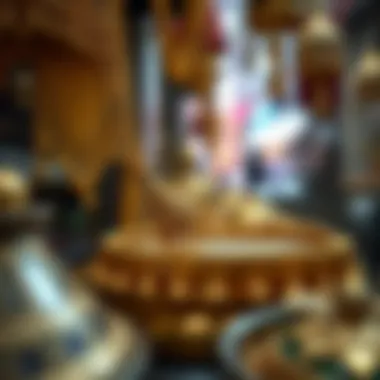
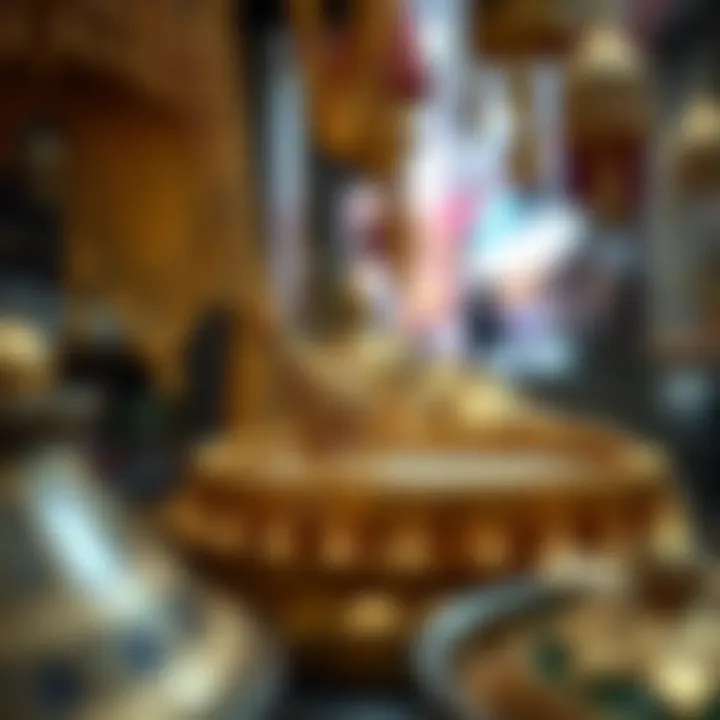
Types of Gold and Jewelry Available
When diving into the intricate world of the Gold Souk in Dubai, one cannot overlook the vast array of gold and jewelry options that greet visitors at every turn. Understanding the varieties of gold available and their cultural significance forms a crucial part of this exploration. This section aims to unveil the complexities and details that make the Gold Souk not just a marketplace but a vibrant hub of commerce and culture.
Gold Varieties and Purity Levels
Gold is not just gold. Within the Gold Souk, it can be found in various forms and purity levels, each carrying its unique value and appeal. The most common purities displayed are 24K, 22K, 18K, and 14K. Let’s break down what these figures mean and why they matter.
- 24K Gold: This represents pure gold, with no alloy metals mixed in. It is soft and malleable, making it ideal for intricate designs but not necessarily practical for everyday wear.
- 22K Gold: Slightly more durable than 24K, 22K gold is a popular choice in jewelry, particularly in the Middle East. It strikes a balance between purity and strength, retaining the vibrant color of gold while offering enhanced durability.
- 18K Gold: Comprising 75% gold and 25% other metals, this is a common option for jewelry makers who want to add strength without compromising too much on gold content. It offers a different color palette depending on the alloy used.
- 14K Gold: This contains 58.3% gold and is more affordable, making it accessible for a wider audience. Often used in everyday jewelry, it combines good durability with a reasonable gold content.
The choice of gold purity often reflects individual preferences and cultural practices. For some, the allure of 24K gold holds unprecedented value, while others may opt for 22K as a symbol of love or prosperity.
While exploring the Gold Souk, take note of the intricate craftsmanship, like the delicate filigree work or elaborate motifs that often adorn these pieces. The designs often tell stories of tradition and art passed down through generations.
Cultural Significance of Gold Jewelry
Gold jewelry in the Middle East, and in Dubai specifically, extends beyond mere adornment. It’s interwoven with cultural traditions, significant life events, and community interactions.
- Weddings and Celebrations: In many Arab cultures, gold jewelry is an essential part of wedding preparations. The bride often receives elaborate pieces that signify wealth and family status. These pieces are not just gifts but are often viewed as a form of financial security for the bride.
- Cultural Identity: For many residents, especially expatriates, wearing gold jewelry can signify a connection to their roots or heritage. Similarly, it can serve as a social marker among diverse communities.
- Gift-giving Traditions: Giving gold jewelry as gifts during holidays, births, or special occasions illustrates the respect and value placed on relationships. It is common for family members to present gold pieces as symbols of love and commitment.
- Investment Value: Beyond its aesthetic appeal, gold is viewed as a timeless investment. Many see it as a hedge against economic uncertainties. During tough times, selling these treasured pieces can provide financial relief.
In summary, the types of gold and jewelry available in Dubai’s Gold Souk are not merely commodities; they are representations of culture, tradition, and personal stories. They carry significance that transcends their monetary value, intertwining the fabric of social life within this bustling marketplace. Engaging with these treasures allows not just for a purchase but also for a deeper understanding of the rich heritage associated with gold in this vibrant city.
Bargaining Culture
Bargaining is not merely an exchange of numbers; it is a deeply rooted tradition in the Gold Souk, one that speaks volumes about the dynamics between buyers and sellers. This cultural practice is emblematic of the Arab heritage, where negotiating terms can often be seen as a dance, a subtle play of words and expressions that reflects trust and mutual respect. Entering the Gold Souk means stepping into a vibrant arena where the hustle and bustle comes alive with lively conversations and spirited negotiations.
This cultural exchange is essential for several reasons. First, it allows buyers to engage directly with sellers, establishing a rapport that can lead to better deals and insights. Imagine haggling over a beautiful piece of jewelry—instead of simply asking for a price tag, you might learn about the artist's background or the story behind the necklace's intricate design. Such information adds substantially to the piece's value, both financially and sentimentally.
Moreover, bargaining empowers consumers. It enables buyers to advocate for themselves and to strategize around their budget constraints. Those who embrace the art of negotiation often find themselves leaving the market with items that reflect both beauty and their savvy skills—all while having fun in the process. Yet, it's essential to approach this practice with respect and cultural sensitivity; the goal is a fair transaction, not a conquest.
Understanding the Art of Negotiation
Navigating the negotiation process in the Gold Souk is an intricate craft that blends psychological acumen with local customs. In essence, understanding the subtleties of negotiation can empower buyers to secure better prices and terms. Many first-time visitors might think that negotiation is an aggressive sport, but in reality, it operates more like a collaborative symphony.
When engaging in negotiations, it’s wise to consider the following aspects:
- Body Language: Your demeanor can convey as much as your words. A relaxed posture and friendly demeanor go a long way.
- Opening Offers: Starting low yet reasonable shows both your awareness and your willingness to compromise.
- Listening: Pay attention to the seller's responses. Their words often guide the direction of the negotiation.
Key Tip: The more informed you are about gold prices and trends, the stronger your position will be when discussing prices. Doing a little homework on the current market rates can make a significant difference in the outcome.
Tips for Successful Bargaining
When it comes to bargaining in Dubai's Gold Souk, following some practical steps can enhance your experience:
- Do Your Research: Understand the current market trends for gold and jewelry. Websites like Investopedia can provide valuable insights.
- Know What You Want: Before stepping into a shop, identify which items catch your eye. This helps in focusing your bargaining efforts.
- Set a Budget: Have a clear financial limit in mind. This is critical to avoid overstepping and feeling regret afterward.
- Be Polite and Patient: Rushing the process may lead to misunderstandings. A courteous approach fosters good relations.
- Be Prepared to Walk Away: Sometimes the best negotiation tactic is showing that you're willing to leave if a deal isn’t to your liking.
Bargaining is an art form, and grasping its nuances can transform a simple purchase into a highly rewarding cultural exchange. Whether you are a seasoned buyer or a first-time visitor, immersing yourself in this practice will not only enhance your shopping experience but also make you part of the rich tapestry that is the Gold Souk.'
Tourist Experience
The Gold Souk is not just a marketplace; it stands as a testament to Dubai's rich culture and history. Tourist experience here is paramount for several reasons. Firstly, it's one of the quintessential battlegrounds where the past and the present mingle. Visitors are greeted with the sights and sounds of intricate gold jewelry, opulent designs, and vibrant trade negotiations, all happening amidst an atmosphere steeped in tradition. Tourists not only make purchases but also immerse themselves in a cultural experience unlike any other.
In this bustling market, tourists can tap into the local way of life. They can observe skilled artisans at work, crafting beautiful pieces right in front of their eyes. Also, the souk provides an opportunity to engage with charming traders, often who have centuries of knowledge tucked into their stories. They don't just sell gold; they share rich tales that enrich the shopping experience. The sense of community within the souk, combined with the sheer vibrancy of the space, creates an enchanting ambience that captivates visitors.
Visiting the Souk: What to Expect
When stepping into Dubai’s Gold Souk, anticipate a feast for the senses. This market isn't merely a place to buy gold; it's a labyrinth of stalls and boutiques, each oozing charm and character.
- Visual Overload: Shimmering chandeliers made with gold and diamonds hang from the ceilings. Jewelry of every conceivable design is on display, from traditional Arabic pieces to modern fashion statements.
- Culinary Delights: You cannot overlook the irresistible local treats in or around the souk. Street vendors sell everything from dates to aromatic spices. The fusion of scents adds a whole new layer to the experience.
- Cultural Exchange: Each shopkeeper isn't just a seller; they are a custodian of culture. A simple inquiry about a necklace might open the door to stories about its significance or craftsmanship, allowing visitors to bond over shared interests.
Expect to spend hours wandering through this gold-laden bazaar, but don't forget to keep your bargaining skills sharp!
Popular Attractions Nearby
The Gold Souk is not an isolated gem but rather part of a larger mosaic of attractions that draw visitors from across the globe. A few steps away, tourists can explore:
- The Spice Souk: Located just around the corner, this market offers a myriad of spices, from turmeric to saffron. The fragrant stalls are a perfect complement to the gold experience, igniting curiosity and appetite.
- Dubai Creek: A short walk will take you to the pristine waters of Dubai Creek. Here, visitors can witness the traditional abras (boats) ferrying people across the water, a sight that reflects the city's pioneering transport history.
- Al Fahidi Historical Neighborhood: Nearby, this area showcases Dubai's past through the beautifully restored buildings, art galleries, and museums. Taking a stroll here offers an escape from the ultra-modern backdrop that dominates the rest of Dubai.
"The Gold Souk offers more than just gold; it’s an encounter with history, culture, and the heart of Dubai itself."
The combination of attractions nearby makes the Gold Souk a holistic tourist destination. It's a place where joy of shopping meets cultural exploration—truly an experience worth savoring.
Authenticity and Quality Assurance
The Gold Souk in Dubai stands out not only for its extensive array of gold items but also for the importance of authenticity and quality assurance. In an expansive marketplace where the allure of shimmering gold can easily captivate visitors, understanding how to navigate through authenticity verification is crucial for ensuring a legitimate purchase. The reputation of the Gold Souk is heavily anchored in the trust of its merchants and the assurance of quality in the products they offer.
When one considers investing in gold, whether for personal use or as an asset, knowing that the items are genuine and of high quality forms the bedrock of a successful transaction. This section will unpack the essential elements that surround authenticity and quality assurance, delving into certifications, guarantees, and how to spot quality gold.
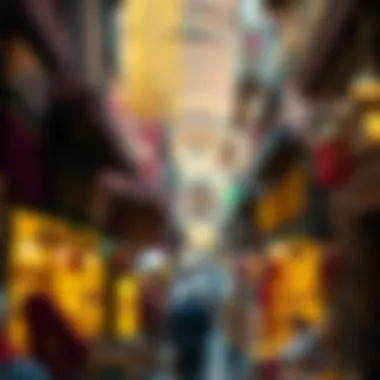
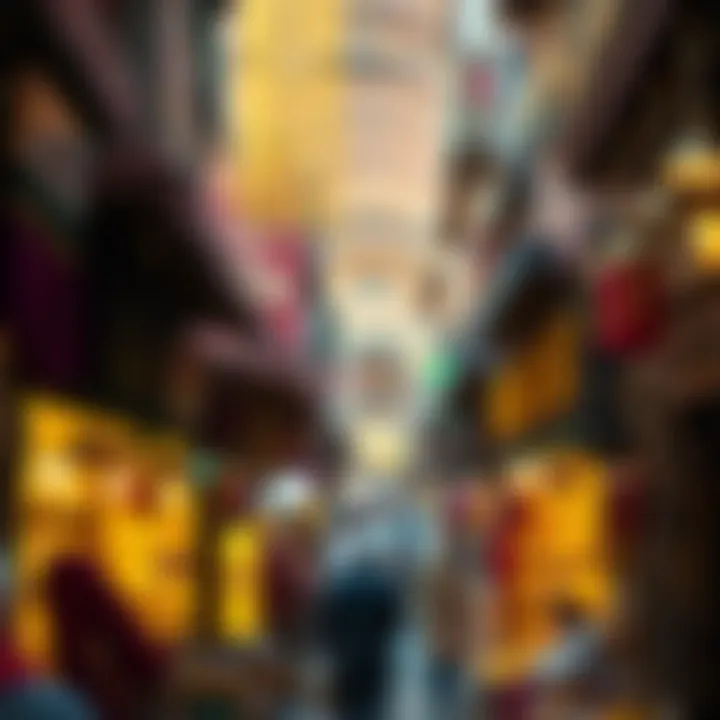
Certifications and Guarantees
Certifications play a pivotal role in the gold buying process. In Dubai, the presence of the Dubai Gold and Commodities Exchange (DGCE) and the Dubai Multi Commodities Centre (DMCC) establishes a framework for trust. Vendors in the Gold Souk often display their licenses issued by these regulatory bodies, which serve as proof of adherence to stringent quality standards.
Some common certifications you might encounter include:
- Dubai Assay Office Certification: This certifies the purity of gold sold in the souk, ensuring that consumers can trust the metal’s authenticity.
- International Standards: Many stores align with international norms like ISO standards that further bolster their credibility.
- Local Trade Licenses: Validating that merchants comply with local commerce regulations ensures that they operate within legal frameworks, further building consumer trust.
Moreover, reputable sellers often offer guarantees that include options for refunds or exchanges. This commitment not only protects buyers but also signifies the merchant's confidence in the quality of their wares.
Recognizing Quality Gold
Navigating the world of gold can feel overwhelming, but familiarizing oneself with key indicators of quality can make the experience more manageable. Here are critical factors for recognizing quality gold when wandering through the Gold Souk:
- Karat Measurement: Gold purity is assessed using the karat system, where 24 karats represents pure gold. Be wary of anything lower if you’re seeking quality.
- Hue and Shine: High-quality gold typically has a distinctive warm tone and a metallic luster that catches the eye. Counterfeit gold or low-quality alternatives might appear dull or have an unnatural sheen.
- Weight and Density: Genuine gold has a certain heft to it, different from faux gold. Familiarize yourself with the feel of high-quality gold and compare weights if possible.
- Hallmarks: Look for stamps or engravings that indicate purity and origin. Authentic gold will have recognizable stamps, and knowing these can prevent you from being misled.
Ultimately, equipping yourself with knowledge about certifications and recognizing quality can ensure not just an impressive purchase, but a vital investment. As the saying goes, "Better safe than sorry." Remember, taking the time to verify the authenticity of your gold treasures will pay off in the long run, safeguarding your interests and enriching your experience at the Gold Souk.
Future Trends in Gold Trading
As the world evolves, the gold trading market is also undergoing seismic shifts, particularly in a bustling hub like the Gold Souk in Dubai. These trends are not only shaping how gold is traded but also affecting the broader economic landscape in the region. Understanding these developments is crucial for investors, homeowners, agents, developers, and expatriates, all of whom play pivotal roles in the local market.
Impact of Global Gold Prices
Global gold prices are a reflection of myriad factors, including geopolitical stability, economic performance, and central bank policies. The prices of gold can fluctuate significantly, directly impacting how trading occurs in local markets. For instance, when gold prices rise, buyers may tighten their belts, waiting for a dip before making a purchase. Conversely, during price drops, buying surges as investors see the opportunity for cost-effective acquisition.
- Investor Sentiment: The global market acts almost like a barometer for investor sentiment. A spike in gold prices often indicates a reaction to uncertainty in traditional markets, prompting more buyers particularly among expatriates who may see gold as a safer investment compared to stocks or bonds.
- Investment Shifts: By keeping an eye on global prices, local traders in the Gold Souk can adjust their strategies effectively. For example, when gold prices peak, they may increase their stock of lower-purity jewelry, which remains appealing to price-sensitive customers.
Technological Innovations in the Market
Technology is revolutionizing how gold is traded, ensuring that the Gold Souk remains competitive on a global scale. From online trading platforms to blockchain applications, innovative tools are reshaping the traditional market dynamics.
- E-commerce Growth: More jewelers are establishing online presences, allowing customers to browse and buy gold products without the need to physically visit the souk. This shift caters to an increasingly digital-first consumer base. As a result, local jewellers must adapt their sales strategies to include secure online payment systems and optimized delivery options.
- Blockchain for Authenticity: The use of blockchain technology is gaining traction in gold trading. This type of distributed ledger can provide irrefutable tracking of gold's provenance, enhancing trust among buyers. Consumers are increasingly demanding not only quality but also assurance about the ethical sourcing of their gold products.
Gold Souk and Real Estate Market Interconnection
The interplay between the Gold Souk and the real estate market in Dubai is more than just a passing fancy; it represents a crucial nexus of wealth and investment for both locals and expatriates. As Dubai continues to evolve into a global metropolis, the Gold Souk serves not only as a hub for precious metals but also as a microcosm of the broader economic landscape, influencing property values and investment dynamics in profound ways.
Wealth and Investment Dynamics
In a city where pearls of the past have been replaced by glittering towers, the wealth generated by the Gold Souk plays an instrumental role in shaping investment dynamics within Dubai’s real estate market. The rising income levels from gold trading contribute decisively to a buoyant economy, creating a robust financial environment conducive to real estate investments.
- Financial Liquidity: Traders and buyers frequenting the souk often reinvest their income into properties. This influx of cash bolsters the housing market, attracting both investors looking to capitalize on bullish trends and expatriates keen to settle in a thriving locale.
- Cultural Affinity for Investment: For many, buying gold is a way of storing wealth, but increasingly, it’s modifying into a means to ensure sustainable investments in the realm of real estate. This evolution is driven by a cultural mindset—where gold is not only considered significant for its monetary value but also as a status symbol that prompts property acquisitions.
- Networking Opportunities: The Gold Souk, known for its hustle and bustle, doubles as a networking haven. Business owners often mingle with potential investors, discussing market trends that may influence property pricing or desirability. Such interactions highlight opportunities in real estate that might not be known to outsiders.
Influence on Property Demand
The vibrancy of the Gold Souk has a cascading effect on property demand in the region. The relationship is a multi-layered one, deeply intertwined with socio-economic factors that can sway investor sentiments and housing availability.
- Increased Demand for Residential Properties: As traders flourish in the souk, they seek optimal living conditions, resulting in an escalated demand for residential properties. Developing luxury flat complexes or villas nearby becomes a strategic business move for developers looking to capitalize on the wealth generated from gold sales.
- Commercial Real Estate Connection: Local merchants looking to expand their operations often require commercial real estate to accommodate burgeoning jewelry businesses. The close-knit relationship between retailers at the souk and property developers fosters a vibrant market for shop renovations and new commercial developments in the vicinity.
- Tourism-Driven Real Estate Escalation: As tourists flock to the Gold Souk, the surrounding areas thrive economically, spiking interest in tourism-related properties, including hotels and serviced apartments. This ongoing influx of visitors supports a profitable rental market, benefiting property owners and real estate companies alike.
"In Dubai, gold isn’t just a commodity. It embodies a lifestyle. The juncture with real estate creates opportunities that paint a vibrant picture of wealth distribution and investment habits within the Emirate."
In summary, the dynamics between the Gold Souk and the real estate market reveal much about Dubai’s burgeoning economy. Not only does it serve as a transactional hub, but it also shapes the very fabric of the property landscape, marking a significant avenue of wealth and investment for a variety of stakeholders.
Cultural Heritage and Identity
The Cultural Heritage and Identity surrounding the Gold Souk in Dubai is not just a matter of commerce; it is woven into the very fabric of the city's identity. Beyond being a bustling marketplace filled with gleaming gold and precious gems, the Souk serves as a reflection of Dubai’s rich history and traditions. It stands witness to the stories of generations who have traded, bargained, and celebrated their heritage through the art of jewelry.
The Souk as a Heritage Site
The Gold Souk is often termed a heritage site, showcasing architectural designs and layouts that hark back to traditional Arabian markets. As you walk through the narrow alleys adorned with intricate metalwork and glass displays, it's hard not to be transported to a time when trade was the backbone of the region.
- Cultural Significance: The Souk's architecture, with its clay-tiled roofs and ornate detailing, embodies the essence of Emirati culture, allowing visitors to witness firsthand the craftsmanship that has evolved over centuries.
- Historical Relevance: Established in the late 19th century, the Gold Souk has seen the tides of history shift around it; from its origins as a trading post to its status today as a global gold trading hub. This continuity preserves not only the practice of trade but also the memories of a community.
- Tourism and Education: The Souk attracts countless visitors, providing a chance for tourists to learn about Emirati culture and the significance of gold in local traditions. Its influence extends beyond commerce; it becomes a classroom for visitors from around the world.
"The Gold Souk is not just a place to shop; it's a transaction of culture and history that speaks for the Emiratis."
Community Engagement and Festivals
Community events and festivals hold a profound significance in enhancing the culture surrounding the Gold Souk. Various annual events draw both locals and tourists, creating a vibrant atmosphere that integrates tradition with modern festivities.
- Cultural Festivals: Events like the Dubai Shopping Festival see the Gold Souk come alive with promotions, workshops, and showcases of traditional jewelry-making techniques. These gatherings allow artisans to highlight their skills while attracting locals to partake in their rich cultural heritage.
- Authentic Experiences: Visitors can experience the art of gold-making, giving them a deeper appreciation for the craft itself. Workshops often include hands-on activities, empowering attendees to create their very own pieces, connecting them to the culture of Dubai.
- Community Involvement: Local artisans and merchants play an instrumental role during these festivals. They not only display their wares but also share stories and techniques passed down through generations, creating a bridge between the past and present.
The Gold Souk, through its recognition as a heritage site and its commitment to engaging the community, reinforces Dubai's identity and cultural fabric. Its blend of commerce and tradition creates a unique experience, ensuring that the legacy of the Souk continues to shine bright.
Local and International Competition
In the bustling world of gold trading, competition is just as fierce as a lion's roar. The Gold Souk in Dubai doesn't just contend with local vendors; it faces the relentless tide of international markets as well. Understanding this competitive landscape is key for investors, homeowners, and expatriates looking to navigate their buying decisions or investments in the gold sphere. The dynamics of local and international competition can significantly influence prices, availability, and overall market trends.
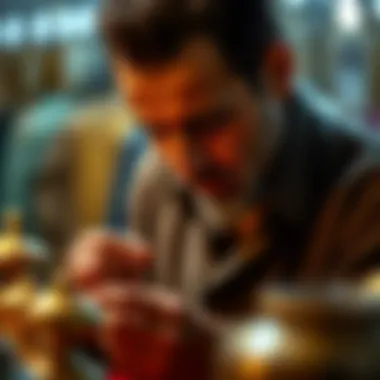
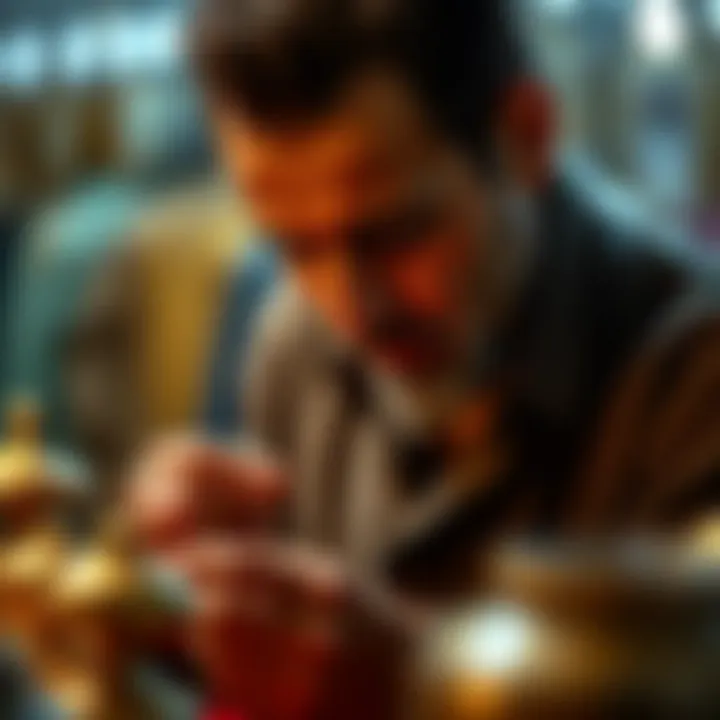
Challenges from Global Markets
The entry of global players in the gold market is more than just a ripple; it’s a tsunami that can affect small local shops with long-standing traditions. Here are some of the notable hurdles faced by the Gold Souk:
- Price Fluctuations: Gold prices are influenced heavily by global economic conditions, which often leads to significant fluctuations. For instance, when gold prices soar on international exchanges, local vendors may find themselves squeezed, unable to offer competitive rates.
- Market Access: Many international companies have better marketing capabilities and distribution networks, which allow them to reach a broader audience. This often leaves local souk traders struggling to capture attention, particularly among younger buyers who are increasingly tech-savvy.
- Regulatory Frameworks: Each country has its own regulations affecting the gold trade. Tightenings or relaxations of these rules in major trading markets like India and China can create unexpected shortages or surpluses in Dubai.
- Consumer Preferences: The tastes of buyers aren’t static; they shift like the sands of the desert. International brands often capture market share by offering innovative designs, which may overshadow traditional offerings found in the Gold Souk.
"In the world of gold trading, adapting to change isn't optional; it's survival."
Positioning of Dubai's Gold Souk
In the arena of gold trading, perception can often be just as critical as reality. The Gold Souk is not just a market; it’s a brand in itself, synonymous with luxury and quality. Here are some ways it has carved out its niche:
- Cultural Significance: The Gold Souk is deeply embedded in the cultural identity of Dubai. Its historic allure draws tourists who wish to experience both traditional and modern gold offerings, enhancing its reputation as a premier shopping destination.
- Strategic Location: Positioned near Dubai Creek, the souk is easily accessible to visitors from all over the world. Its central location caters to both locals and international tourists who seek a glimmer of luxury amidst a vibrant cityscape.
- Diverse Offerings: The Gold Souk prides itself on a staggering variety of gold jewelry, from intricate traditional pieces to contemporary designs, making it a one-stop-shop for those looking to make a purchase.
- Customer Experience: Shopping in the souk is not just about the product; it’s an entire experience. Vendors often engage in storytelling, offering insights into the craftsmanship behind each item, adding a layer of prestige and value to the purchase.
In summary, the Gold Souk stands firm against the backdrop of increasing competition, both localized and global. By understanding these nuances, stakeholders can navigate the market effectively, whether it’s to invest or simply to indulge in the glittering offerings this iconic marketplace has to provide.
For further insights, refer to resources like British Broadcasting Corporation (BBC) and Wikipedia.
Sustainability Practices in Gold Trading
Sustainability practices in gold trading represent a pivotal aspect of the modern marketplace, especially within the context of the Gold Souk in Dubai. The intertwining of ethical sourcing and environmental considerations underscores the growing awareness among investors and consumers about their purchasing power. As the world becomes increasingly sensitive to the environmental footprint of industries, it is crucial to address how gold trading can evolve responsibly. This segment will delve into the cornerstones of sustainable gold trading, highlighting its practical benefits and potential downfalls.
The significance of sustainability in this context is manifold. Firstly, it ensures the protection of social and environmental standards in gold extraction, which frequently involves communities that are already jeopardized. Secondly, adhering to ethical practices adds a layer of credibility to the gold market—something that can elevate Dubai's Gold Souk not just as a place of commerce but as a pioneer in responsible trading. Lastly, understanding these principles can assist investors in making informed decisions that align with a more conscientious economic growth trajectory.
Ethical Sourcing of Gold
Ethical sourcing calls for transparency within the gold supply chain, which is crucial for both buyers and sellers. This encompasses ensuring that gold is mined under fair labor conditions, providing workers with decent wages, and minimizing harm to local communities. It's not just about the gold itself — the social implications of how that gold is obtained reverberate through the fabric of various societies involved in the mining process.
One approach that further aids this ethical endeavor is certification. Institutions such as the Responsible Jewelry Council have established guidelines and criteria that suppliers must meet to ensure that their gold comes from legitimate sources. By prioritizing companies that adhere to these standards, buyers can contribute to a more ethical marketplace. In the long run, this creates an ecosystem where sustainable practices flourish, thereby boosting investor confidence.
"Investing in ethically sourced gold is no longer just a trend; it’s becoming a vital part of conscientious consumerism in the luxury market."
Environmental Considerations
The environmental considerations surrounding gold trading are extensive and complex. Mining activities can result in the degradation of ecosystems, pollution of water sources, and destruction of habitats. Therefore, implementing sustainable mining practices is imperative to mitigate these adverse impacts. Using technology to minimize ecological damage is one of the forefront solutions available today.
By adopting eco-friendly extraction techniques, companies can reduce their carbon footprints and adhere to regulations that protect the environment. For instance, utilizing renewable energy sources in mining operations can substantially lessen emissions. Another notable step includes recycling gold from old jewelry—a practice gaining momentum within Dubai's Gold Souk. Not only does this help decrease the demand for newly mined gold, but it also fosters a culture of sustainability among consumers.
In sum, making conscious choices in the gold sector is indispensable not only for contemporary stakeholders but also for future generations. As awareness grows about the interconnectedness of economy and environment, it becomes imperative for the Gold Souk in Dubai to lead by example, steering the industry toward a more sustainable future.
Tips for Prospective Buyers
When it comes to visiting the Gold Souk in Dubai, being well-prepared can make all the difference. The souk is renowned not just for its dazzling array of gold jewelry, but also as a hub of economic activity that’s pivotal to the local culture. For buyers, both local and international, understanding the elements that shape your experience is crucial. This can enhance your visit and maximize your purchase satisfaction.
Research and Preparation
Before stepping foot inside the Gold Souk, it's essential to do a bit of homework. The first step? Familiarize yourself with the kinds of gold available. Learn about the distinctions between various carats, such as 22K or 18K gold. Knowing what suits your needs can save you headaches later on. Additionally, read up on current market trends — prices fluctuate in response to global market conditions. Having this intel can steer you away from overspending due to a lack of awareness.
Another layer of preparation involves understanding the cultural significance attached to gold in the region. Gold jewelry often serves not just as decoration but as a statement of wealth and tradition, especially among locals. This context can help buyers appreciate the craftsmanship and motives behind certain pieces.
Furthermore, approach the visit with an understanding of the local bargaining culture. If you're keen on negotiating prices, practice might come in handy. Familiarizing yourself with typical pricing can serve as your baseline. Some say the best prices are found towards the end of the day when shopkeepers are eager to meet their sales targets — a useful tip tucked away for savvy shoppers.
Understanding Market Timing
Timing your visit to the Gold Souk can significantly affect your buying experience. The market typically sees dips in foot traffic during the hotter parts of the day and tends to get busier in the evening. Shopping during quieter hours can not only lead to a more relaxed experience but also give you more time to negotiate. The rhythm of the souk might be intimidating to first-timers; however, aiming for off-peak hours can ease the intensity.
Additionally, market timing in a broader sense — understanding when to buy gold — plays an influential role. Seasonal trends often influence prices; they can spike during festive periods or major holidays when demand is high. Conversely, prices can dip during off-seasons. For instance, close monitoring of global gold prices can give prospective buyers clues on favorable times to make their purchases. Keeping tabs on financial news platforms such as Reuters or Bloomberg can assist you in spotting these patterns.
Finally, consider special offers or promotions that shops might have when you plan your visit. Certain vendors may run sales during specific months, presenting an opportunity to snag a deal on that stunning piece you've had your eye on.
"Those who prepare well find the best treasures at the souk. A little knowledge goes a long way in appreciating both the art of the gold and the act of buying it."
By doing your research and being mindful of timing, prospective buyers can enhance their experience at the Gold Souk. With its vibrant atmosphere and vast selection, this famous market offers a unique shopping adventure — one that rewards those who come equipped with the right knowledge.
The End
In wrapping up our exploration of the Gold Souk in Dubai, it’s crucial to grasp its multifaceted importance. The souk acts not just as a marketplace but as a vibrant symbol of trade, culture, and heritage. This bustling hub draws in tourists and investors alike, showcasing the exquisite craftsmanship of jewelry and the allure of gold. Further, it forms an integral part of Dubai's economy, contributing significantly to local GDP while also serving as a liaison between traditional values and contemporary commerce.
Summary of Insights
The key insights that emerge from this analysis highlight the rich tapestry of experiences that the Gold Souk offers:
- Economic Vitality: The souk boosts Dubai’s economy, creating numerous jobs and supporting local businesses.
- Cultural Significance: Beyond commerce, the Gold Souk embodies cultural heritage and community engagement, attracting a diverse clientele.
- Expectations for Tourists: Visitors can immerse themselves in the art of bargaining, making the experience both thrilling and educational.
- Quality Assurance: Trust in the market is upheld through stringent quality checks and certifications, ensuring buyers leave satisfied.
- Future Potential: With evolving global trends and sustainability practices, the Gold Souk is poised to adapt and flourish in the coming years.
Future Prospects for the Gold Souk
Looking ahead, the future of the Gold Souk seems promising, yet it also faces challenges. The fluidity of global gold prices and economic shifts dictate much of its operations. However, the resilience shown thus far illustrates the souk’s ability to adapt.
- Embracing Technology: As digital currencies and online trading rise, traditional markets must consider integrating these innovations to stay relevant. The Gold Souk might benefit from adopting more e-commerce possibilities, catering to tech-savvy consumers.
- Sustainability Movements: Increasingly, consumers are favoring ethically sourced products. The Gold Souk has opportunities to lead the charge in sustainable gold trading, promoting environmentally friendly practices and transparency in sourcing.
- Tourism Growth: Dubai’s vision as a global hub can amplify tourist footfall. Enhanced marketing efforts targeting international travelers can further entwine the Gold Souk's legacy with Dubai's image.







